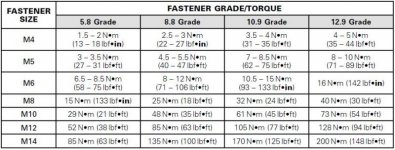Gray Ghost
New member
I noticed errors in the 2013 and 2010 manuals in the fastener grade/torque table. If you are using a SAE torque wrench be very careful using that table. I am attaching a screenshot of the table. If the metric reading is below 25 N-m, the corresponding SAE measurement should be lbf-in (inch-pounds). Many of the values are listed as lbf-ft (foot-pounds) which can lead to problems if you are following that table.
If you want to verify the figures there is an online converter at: http://www.convert-me.com/en/convert/torque/

If you want to verify the figures there is an online converter at: http://www.convert-me.com/en/convert/torque/

